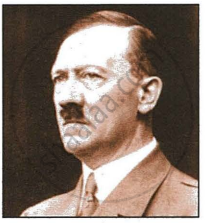Advertisements
Advertisements
प्रश्न
Picture Study

- Identify the leader in the picture. How did he establish a totaltarian state in his country?
- State three factors that led to the rise of Nazism.
- State four similarities between the ideologies of Nazism and Fascism.
दीर्घउत्तर
उत्तर
- The leader shown in the picture is Adolf Hitler. He did not trust the parliamentary system of governance, so he removed all opposition and established a totalitarian state.
- Hitler centralised all power under his control, suppressing opposition and promoting Nazism.
- He changed the federal system into a unitary government.
- Hitler took direct control over Prussia by becoming its governor.
- In 1934, provincial legislatures were dissolved, giving full power to the central government.
- Political parties other than the Nazi Party were banned.
- Restrictions were imposed on the press, public speeches, and publishing articles.
- Even Nazi Party members who questioned his authority faced harsh consequences.
- The Gestapo, a secret police force, monitored citizens’ activities.
- Individuals suspected of disloyalty were arrested or executed without trial.
-
- Defeat in the First World War: The Treaty of Versailles imposed harsh penalties on Germany, humiliating the nation. They were forced to pay reparations amounting to $33 billion, and their military was reduced to just 100,000 soldiers. Hitler encouraged Germans to ignore the treaty, promising to rebuild their empire and recover lost colonies.
- Fear of Communism: After the Russian Revolution, communist influence grew in Germany. The communists won several seats in the Reichstag, alarming many Germans. Hitler warned that German communists would become puppets of Soviet Russia, persuading the people that only Nazism could stop the spread of communism.
- Economic Crisis: Germany's economy suffered from the consequences of the Treaty of Versailles. Agricultural production declined, trade contracts were lost, and foreign countries imposed tariffs on German goods. Unemployment increased, and by June 1931, farmers were in heavy debt, with loans totalling $300 million.
- Here are the similarities between the ideologies of Nazism and Fascism in simple terms:
- Both believed in totalitarian rule, meaning complete control by a single leader or party.
- They rejected democracy, believing it weakened the country.
- They held that the state was supreme and individual freedoms could be suppressed.
- Both supported a system with one party and one leader to maintain control.
- They believed in aggressive nationalism and sought to expand their territories.
- War was seen as a tool to achieve national goals.
- Both ideologies promoted anti-communist, anti-democratic principles, and intense nationalism.
shaalaa.com
क्या इस प्रश्न या उत्तर में कोई त्रुटि है?
